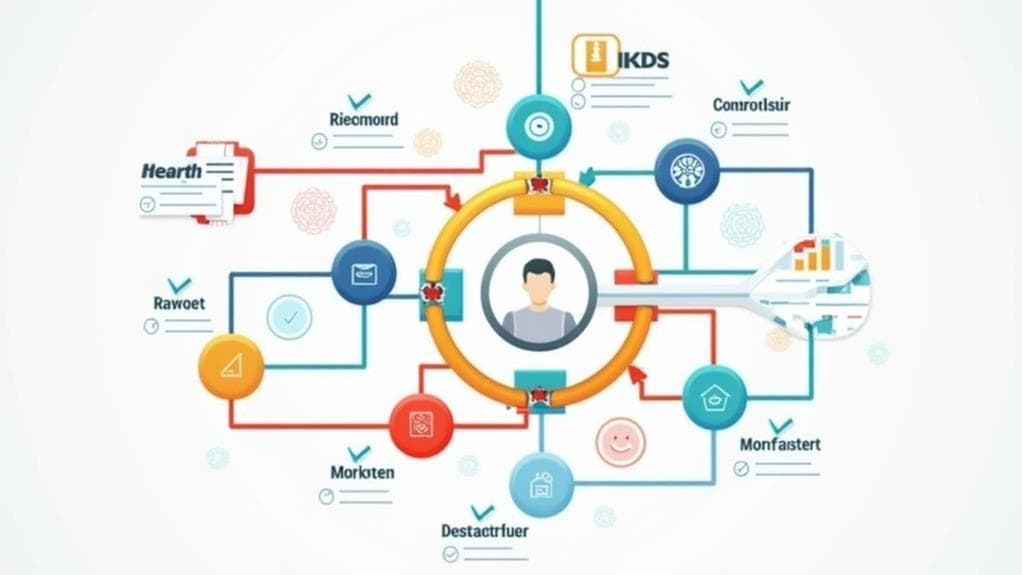Change management templates are crucial tools for navigating organizational transitions. You’ll find various types, including change proposals, communication plans, impact assessments, and stakeholder analyses. These templates help you articulate proposed changes, streamline information flow, identify potential consequences, and assess key stakeholders. They also assist in managing risks, planning training, evaluating feedback, and analyzing costs and benefits. By using these templates, you’ll ensure smoother workflows, better alignment among team members, and more successful change implementations. Exploring each template type can provide you with a comprehensive toolkit for effective change management.
Types of Change Management Templates

Change management templates frequently serve as essential tools for organizations navigating transitions. They not only facilitate smoother workflows but also ensure that teams remain aligned throughout the process.
As you embark on your change journey, you’ll find various templates designed to streamline the process and ensure nothing falls through the cracks, as highlighted in the Change Consultant Client Accelerator Overview.
One of the most crucial tools in your arsenal is the change proposal template. It’s your launching pad, allowing you to clearly articulate the need for change and its expected outcomes.
Paired with this, you’ll want to employ a change impact assessment template to evaluate how the proposed changes will affect your team and systems.
Communication is key in any change initiative, and that’s where the communication plan template comes in. It’ll help you map out your strategy for keeping everyone in the loop throughout the change lifecycle.
To maintain transparency and efficiency, you’ll need a change management log template to track and resolve change requests.
Lastly, don’t overlook the organizational change management plan template. It’s your comprehensive guide for managing the broader impacts of change, addressing potential resistance, and ensuring a smooth transition for your entire organization.
These templates will equip you with the structure needed to navigate change successfully.
Special offer: 9000+ Project Management and Business Templates for just $49!
Change Proposal Template
The Change Proposal Template serves as a critical tool in your change management process, encompassing key components such as the proposed change description, justification, outcomes, timeline, and costs.
Leveraging business growth strategies can further enhance the effectiveness of your proposal by ensuring it aligns with your organization’s objectives.
You’ll find this template invaluable for articulating the necessity and benefits of changes, while providing decision-makers with essential cost-benefit analyses.
To implement effectively, ensure all stakeholders contribute to and review the proposal, facilitating a smoother approval process and alignment across your organization.
Purpose and Key Components
Setting out to propose organizational changes requires a well-structured document that clearly articulates the need for transformation. The Change Proposal Template serves as your essential tool in this process, guiding you through the crucial elements of your proposal. Its primary purpose is to communicate the rationale, scope, and expected outcomes of your proposed changes effectively.
When crafting your proposal, focus on key components that will resonate with decision-makers. Start by clearly defining the problem you’re addressing and the solution you’re proposing.
Estimate the time and resources required for implementation, demonstrating your understanding of the project’s scope. Include a thorough cost-benefit analysis to showcase the financial implications and potential advantages of the change.
Implementation and Approval Process
Implementing a change proposal requires a systematic approach to ensure its success. The Change Proposal Template serves as your foundation, guiding you through the critical steps of the implementation and approval process. As you complete the template, you’ll articulate the rationale, expected outcomes, and necessary resources, fostering stakeholder engagement and minimizing resistance to change.
Your template should include a comprehensive cost-benefit analysis, demonstrating the financial implications and justifying the investment. This analysis will help you gain stakeholder approval by presenting a clear picture of the proposed change’s value.
Remember, the template is your first step in the change management process, aligning all parties and ensuring thorough review before moving forward.
As you navigate the implementation process, use the template to keep stakeholders informed and engaged. By clearly outlining the required time, resources, and potential costs, you’ll facilitate informed decision-making and build support for your proposal.
Ultimately, the Change Proposal Template empowers you to lead your organization through change with confidence, fostering a sense of belonging and shared purpose among team members.
Communication Plan Template

Designed to streamline the flow of information during organizational transitions, a Communication Plan Template serves as a crucial roadmap for change managers. This strategic tool outlines effective strategies for conveying changes to stakeholders throughout the project lifecycle, ensuring clarity and minimizing resistance.
By integrating stakeholder analysis, you’ll identify key audiences, their communication needs, and preferred engagement methods, enhancing the effectiveness of your messaging. Additionally, leveraging LinkedIn can also play a vital role in enhancing audience needs awareness and tailoring communication efforts effectively.
Your communication plan template should include mechanisms for feedback collection, allowing stakeholders to voice concerns and insights. This approach helps refine your communication strategy and fosters a sense of inclusion among team members.
Remember, a well-structured plan significantly improves user buy-in and support for changes, ultimately contributing to the success of your change initiative.
To maintain relevance, regularly update and review your communication plan. This ensures it remains responsive to the evolving needs of your organization and its stakeholders during the change process.
Impact Assessment Template
The Impact Assessment Template helps you identify and quantify the potential consequences of organizational changes.
You’ll use this tool to systematically analyze how proposed alterations will affect your people, processes, and systems.
Identifying Potential Consequences
When undertaking organizational changes, it’s crucial to anticipate potential consequences. An Impact Assessment Template serves as an invaluable tool in this process, helping you identify and analyze the effects of proposed changes on your organization’s people, processes, and systems.
By using this template, you’ll be better equipped to make informed decisions and manage the change implementation process effectively.
As you work through the Impact Assessment, consider the following potential consequences:
- Shifts in team dynamics and productivity
- Alterations to existing workflows and procedures
- Changes in resource allocation and budgeting
- Impacts on customer relationships and satisfaction
- Modifications to organizational culture and values
The template guides you in identifying stakeholders affected by a change, outlining the nature of the impact, and estimating associated risks and benefits.
This comprehensive approach ensures that you’re considering all aspects of the change, from timing considerations to potential resistance.
By proactively addressing these factors, you’ll foster smoother transitions and enhance stakeholder engagement throughout the process.
Quantifying Change Effects
Building on the importance of identifying potential consequences, quantifying change effects through an Impact Assessment Template provides a structured approach to evaluating organizational shifts.
This management model enables you to assess the full scope of a proposed change, helping you and your team make informed decisions.
When you’re using the Change Impact Assessment Template, you’ll analyze how people, processes, and systems are affected by the change.
You’ll estimate both positive and negative impacts, allowing you to prepare stakeholders for the transition and reduce resistance.
The template guides you through tracking steps such as timing of impacts, associated risks, and necessary mitigation actions.
Stakeholder Analysis Template

Five key components form the backbone of an effective Stakeholder Analysis Template. This essential tool helps you identify and manage stakeholders throughout the change management process, ensuring smoother transitions and better outcomes.
When crafting your Stakeholder Analysis Template, include:
- Stakeholder names and roles
- Contact information
- Level of support or resistance
- Influence and interest levels
- Engagement strategies
By categorizing stakeholders based on their influence and interest, you’ll prioritize your communication efforts effectively. This strategic approach allows you to tailor your messaging and address specific concerns, fostering a sense of belonging among all involved parties.
As you navigate stakeholder dynamics, regularly update your template to maintain proactive relationships. This ongoing assessment ensures you’re always equipped with the most current information, enabling you to adjust your engagement strategies as needed.
Change Log Template
A Change Log Template serves as a crucial tool for tracking and managing change requests throughout your project.
You’ll find it essential for documenting key details such as requestor information, dates, priorities, and resolutions, enabling efficient prioritization and addressing of modifications.
Purpose and Key Elements
While managing projects, you’ll find that a Change Log Template serves as a crucial tool for tracking and controlling modifications throughout the project lifecycle. This essential component of your change management plan example helps you maintain transparency and accountability for each alteration.
The template typically includes key elements that allow you to effectively manage and prioritize changes:
- Requester’s name
- Date of request
- Detailed change description
- Current status (e.g., pending, approved, implemented)
- Priority level
By incorporating these elements into your change request form template, you’ll create a comprehensive record that informs decision-making and enhances your change management processes. This template enables you to assess the impact of changes on project timelines, budgets, and resources, ensuring you’re always aware of the project’s current state.
Regularly updating your change log promotes clear communication among stakeholders, fostering trust and collaboration within your team. It also helps define roles and responsibilities for each change, ensuring everyone knows their part in the process.
Tracking Change Requests
Effectively tracking change requests throughout a project’s lifecycle is crucial for maintaining control and transparency. A change log template serves as your essential tool for this purpose, providing a structured approach to documenting and managing changes. By implementing a comprehensive template, you’ll capture key details such as the requester’s name, date, description, status, priority, and resolution notes for each change.
This systematic tracking enables you and your team to prioritize changes effectively, communicate progress to stakeholders, and minimize confusion. The change log template becomes your single source of truth, fostering accountability and ensuring no requests slip through the cracks.
As you regularly update the log, you’ll enhance transparency and create a valuable historical record. Your change log template isn’t just a static document; it’s a dynamic tool that informs future change management activities.
Implementing Effective Documentation
Implementing a robust Change Log Template forms the cornerstone of effective documentation in change management. This essential tool allows you to better track all change requests throughout your project’s lifecycle, ensuring transparency and fostering trust among stakeholders.
By utilizing a comprehensive template, you’ll enhance your team’s ability to manage changes effectively, leading to smoother project execution and higher success rates. Incorporating change management templates for projects allows your team to systematically approach potential disruptions and minimizes the impact on timelines and budgets. These templates serve as a guiding framework, ensuring that all necessary steps are followed and that communication remains clear throughout the process. As a result, you can foster a culture of adaptability and preparedness within your organization.
Your Change Log Template should include:
- Requester’s name and date of request
- Priority level of the change
- Current status of the request
- Resolution details
- Impact on project timeline and resources
As part of your change management communications plan, the Change Log Template serves as a valuable reference for future activities. It enables you to learn from past changes and continuously improve your processes.
Risk Management Template

A cornerstone of successful change initiatives, the Risk Management Template serves as a vital tool for identifying and addressing potential obstacles. It enables your team to categorize risks by likelihood and impact, prioritizing attention where it’s most needed.
By utilizing this template, you’ll be able to document risk descriptions, assessment criteria, mitigation strategies, and monitoring plans, ensuring comprehensive management of identified risks.
Your Risk Management Template helps evaluate both internal and external risks, fostering a proactive approach to minimizing negative impacts on project outcomes. It enhances communication among stakeholders by providing a clear overview of potential issues and planned responses.
This shared understanding creates a sense of unity and purpose within your team. Remember to update your Risk Management Template regularly to adapt to new information and maintain alignment with project goals throughout the change process.
Training Plan Template
Every successful change initiative hinges on a well-structured training program. A Training Plan Template is a crucial change management-related tool that helps you create the change management strategy needed for implementing the change effectively.
This free template enables you to outline essential training objectives, identify target audiences, and determine the most suitable delivery methods.
When utilizing a Training Plan Template, you’ll:
- Develop a comprehensive timeline for training sessions
- Assess current user knowledge to identify skill gaps
- Tailor training content to maximize effectiveness
- Identify strong users as coaches for peer support
- Align training efforts with the go-live date of new systems
Evaluation and Feedback Template

Feedback serves as the cornerstone of effective change management. The Evaluation and Feedback Template is your key to unlocking valuable insights from stakeholders after implementing a change. This powerful tool allows you to collect structured feedback, measuring the impact against predefined success criteria.
You’ll find sections for both quantitative metrics and qualitative comments, giving you a comprehensive view of the change’s effectiveness. By consistently using this template, you’re fostering a culture of continuous improvement within your organization.
You’ll be able to identify specific challenges encountered during the change process, enabling you to make targeted adjustments in future initiatives. The feedback you gather can be transformed into a detailed report, highlighting both achievements and areas for improvement.
Cost-Benefit Analysis Template
The Cost-Benefit Analysis Template is a crucial tool for organizations navigating change initiatives. It helps you systematically evaluate the financial implications of proposed changes by comparing expected costs against anticipated benefits.
This template empowers you to make informed decisions based on quantitative data and projected ROI.
When using a cost-benefit analysis template, you’ll typically include:
- Implementation expenses
- Ongoing operational costs
- Projected revenue increases
- Anticipated operational efficiencies
- Potential financial risks
By incorporating these elements, you’re able to gain a comprehensive understanding of the change’s impact on your organization.
The template enhances transparency and consistency in the decision-making process, allowing you and your team to align on the rationale behind change initiatives.
Final Thoughts
You’ve now explored a range of essential change management templates. By implementing these tools, you’ll streamline your change initiatives, minimize risks, and maximize stakeholder buy-in. Remember, these templates aren’t one-size-fits-all; adapt them to your organization’s specific needs. Regularly review and refine your approach based on feedback and results. With these strategic resources at your disposal, you’re well-equipped to navigate complex organizational changes and drive successful transformations.





